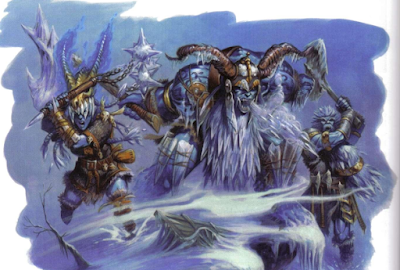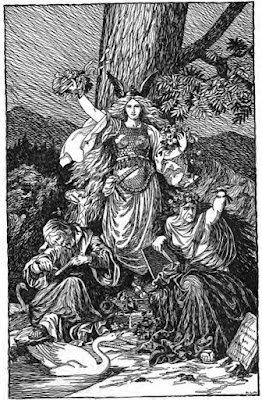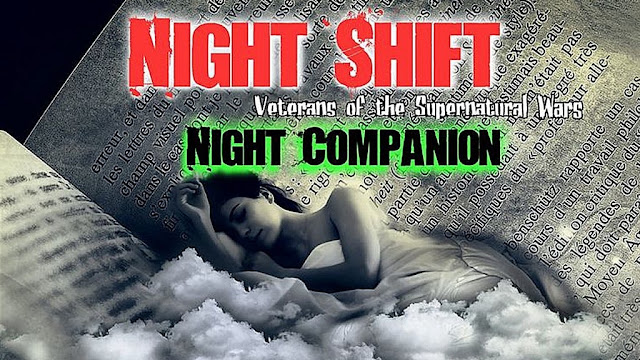I have long been a fan of the AD&D 2nd Ed. Historical References books. I have used the Celts one over and over again with many different versions of D&D and I have been pleased with it. The scholarship on these is a bit better than the Deities & Demigods, but I attribute this to a better budget and more space to explain what they were doing.
Also, the focus was a little different. The D&DG took myths and tried to fit them into the AD&D framework. The Historical References took the myths and described how to play an AD&D game in that world.
It's Norse Week so let's start at the beginning with HR1 the Vikings Campaign Sourcebook.
HR1 Vikings Campaign Sourcebook (AD&D 2nd Edition)
For today's review, I am only going to consider the PDF version of this book from DriveThruRPG. I lost or sold back my original in one of my moves or collection downsize. I will mention details from the physical book as I remember it, but my focus is on the PDF for the details. In most cases the material is 100% the same, the difference coming from the fold-out map, which is separate pages in the pdf.
HR1: Vikings Campaign Sourcebook (1992), by David "Zeb" Cook. Illustrations by Ned Dameron and cartography by David C. Sutherland III. 96 pages, black & white with full-color maps.
The first book of the Historical Reference series covers the Viking raiders of Scandinavia. It is not a separate game world per se, since it deals with Pagan Europe after the fall of Rome, but it is a fantastical Europe where dragons fill the seas, troll-blooded humans walk among us, and somewhere out there in the wilderness, a one-eyed man wanders the land.
Chapter 1: Introduction
This chapter covers the very basics, starting off with what people usually get wrong about the Vikings. These guys are not Hägar the Horrible or even the interpretations of Wagner. They do point out that "Vikings" are also not really a people, but a lifestyle that some people engaged in.
This section also covers how to use this book, specifically how to use this book about Vikings and the history of their raids with the AD&D 2nd Rules. We get into more specific details in the next chapters.
Chapter 2: A Mini-Course of Viking History
Starting with the raid at Lindisfarne in 793 CE the book covers a very basic history of the Northmen's lands, the lands they raided, and their culture and history. The focus here though is through the lens of an AD&D game, not a historical introduction. The book is clear on this.
Details are given, with maybe extra focus on England and France (though they are not called that yet) but that is fine. There is a very nice timeline running across the top of the pages of this chapter that is rather handy. The time period, roughly 800 to 1100 CE agrees with most of the scholarship on "Viking History" so that works fine for here as well.
There is a nice list of settlements and cities the Vikings targeted. Not a full list, but it gives you an idea of how much of Europe, Northern Africa, and even parts of Asia the Vikings would roam.
There is a page or so of suggested readings. Likely the best at the time. The chapter does set you nicely to explore these ideas further.
Chapter 3: Of Characters and Combat
Here we get into game writing proper. We start with what races you will find in a Viking-themed campaign. Obviously, we are talking mostly humans here. Humans can gain a "Gift" something that makes them special such as "Rune Lore" or "Bad Luck" or even a Seer. There is a new "race" the Troll-born. These are stronger than average humans due to troll-blood in their veins. They get a +1 to Strength, Constitution and Intelligence but a -1 to Wisdom and a -2 to Charisma. They have Infravision and are limited to 15th level in their classes. They are not born with Gifts.
Next, we cover the changes to the Character Classes from the PHB. Fighters on the whole tend to be unchanged as are Rangers and Thieves. Classes not allowed are Clerics, Paladins, Druids, and Wizards, though specialty mages are allowed if they are Conjurers, Diviners, Enchanters, Illusionists, Necromancers. While this could be a negative for some I like the idea of limiting classes for specific campaigns. Two new sub-classes of the Warrior are added, the Berserker and the Runecaster. Both do pretty much what you might suspect they do. The berserker is actually rather cool and while the obvious roots here are the barbarian and berserker monster from AD&D 1, there is enough here to make it work and be interesting too. Runecasters know runes as detailed in the next chapter.
The "forbidden" classes can be played, if they are outsiders.
Lip service is given to the detail that the Vikings were predominantly men. Though new archaeological finds are casting some doubt that they were exclusively so. This book does give some examples of how warrior women were known. They emphasize that player characters are always exceptional.
There is a section on names (including a list of names), homelands, and social class.
In the purist AD&D 2nd ed section, we get some new Proficiencies.
Chapter 4: Rune Magic
This covers Rune Magic. An important feature of Viking Lore. What the runes are and how to use them in AD&D 2nd Ed terms are given. A lot of these are minor magics, say of the 0-level or 1st-level spell use. I personally don't recall them being over abused in games, but they are a really nice feature to be honest.
Chapter 5: ...And Monsters
Monsters are discussed here, starting with which existing monsters can be used from the AD&D 2nd Monstrous Compendium. Following this some altered monsters are given. For example, there is the Gengånger which is a zombie with some more details.
Dwarves and Elves are given special consideration, as are trolls and giants.
There is not however any "new" monsters in the AD&D 2nd Ed Monstrous Compendium format. We will get those in the Celts book, but that is next time.
The section is split with a "centerfold" map of Europe.
Chapter 6: Equipment and Treasure
Vikings were Vikings because of the treasure they sought. They also had the best ships in Europe at this time. So let's spend some time with these.
We start with a section on money. For the game's simplicity, these are reduced to a couple of systems. Coins are usually categorized by make-up and weight. There is some good material here really and something that most games should look into.
Treasure covers the typical treasures found. Also, treasure was a central piece of Viking lore; it was how chieftains paid their men, it was what they stole from others, and it was also how they were paid off NOT to steal. Some space is given to Magic Items as well. This is an AD&D game after all. Some "typical" magical treasure is discussed and some that are not found at all. A few new items are also detailed.
Chapter 7: The Viking Culture
This chapter gives us are biggest differences from a typical AD&D game. For illustrative purposes, we follow a young Viking, Ivar Olafsson, in a year of his life. Now I rather liked this because it gave me a character situated in his life and culture. While it is not the most "gamble" material it is good background material.
There is a section on Social Ranking and a little more on the role of Viking women. I think after 6 seasons of watching Katheryn Winnick kick-ass as Lagertha in Vikings, this section will be read and cheerfully ignored. That is great, but this bit does talk about, and support, the image that Viking women had it better than their counterparts in the rest of Europe.
We also get into the sundries, quite literally; Food, drink, homes, farms, and trade. There is a section on religion with lots of nods towards the AD&D 2nd Ed Legends and Lore.
Chapter 8: A Brief Gazetteer
AD&D 2nd Ed is celebrated not really for its advances in game design or rules, but rather the campaign worlds. This book, and this section, in particular, is a thumbnail of why these celebrations are merited. Or, as I call it, just give me a map! This section is more than a map and maybe not as much as the famed Mystara Gazetteers, but the relationship is not difficult to pick out.
This covers, rather briefly (as it says in the title), the lands the Vikings would roam to. And there are a lot of those! In addition to the lands of Europe, Africa, Asia, and yes even North America, we get the fantastic worlds of the Vikings. If I had done this book this would have been Chapter 2 or 3 at the very least. This chapter is all too brief in my mind.
We get a longship design at the end and in the PDF what was the fold-out map.
--
So in truth a really fun resource. The AD&D game material is there, but this book could be used with pretty much any version of D&D or even many other games. 3rd Edition/Pathfinder players might lament the lack of Prestige Classes, but the Rune MAgic section can be easily converted to a Feat system. 5th Edition Players would need to work the Berserkers into a Barbarian sub-class/sub-type, but that would be easy enough.
It is not a perfect resource, but it is really close. I am really regretting selling off my physical copy now.














